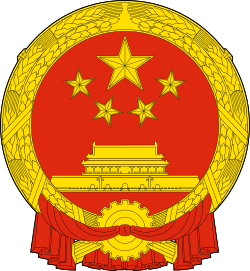Three Represents
 |
| This article is part of a series on the politics and government of China |
|
|

The Three Represents (simplified Chinese: 三个代表; traditional Chinese: 三個代表; pinyin: Sānge Dàibiǎo) or the important thought of Three Represents (simplified Chinese: “三个代表”重要思想; traditional Chinese: “三個代表”重要思想; pinyin: “Sān ge dàibiǎo” zhòngyào sīxiǎng) is a guiding socio-political theory credited to Jiang Zemin, which was ratified by the Communist Party of China at the Sixteenth Party Congress in 2002.
Jiang Zemin first introduced his theory on February 25, 2000 while on an inspection tour in Maoming, Guangdong province. He was attempting a comprehensive summary of the party's historical experience and how to adapt to new situations and tasks when he stated:
A review of our Party's 70-plus-year history elicits an important conclusion: our Party earned the people's support during the historical periods of revolution, construction and reform because it always represented the requirements for developing China's advanced productive forces, the orientation of China's advanced culture and the fundamental interests of the overwhelming majority of the Chinese people. The Party also earned popular support because it fought tirelessly to realize the fundamental interests of the country and the people by formulating a correct line, principles and policies. Today, humanity once again stands at the beginning of a new century and a new millennium. How our Party can better effectuate the Three Represents under the new historical conditions is a major issue all Party comrades, especially high-ranking Party cadres, must consider deeply.[1]
The official statement of the ideology stipulates that the Communist Party of China should be representative to advanced social productive forces, advanced culture, and the interests of the overwhelming majority.
Synopsis
The formal statement of the theory is:
This experience and the historical experiences gained by the Party since its founding can be summarized as follows: Our Party must always represent the requirements for developing China's advanced productive forces, the orientation of China's advanced culture and the fundamental interests of the overwhelming majority of the Chinese people. These are the inexorable requirements for maintaining and developing socialism, and the logical conclusion our Party has reached through hard exploration and great praxis.[2]— Detail from Jiang Zemin's work report at the 16th CPC Congress, November 8, 2002
One possible interpretation of the "Three Represents":
- "Represents advanced social productive forces" stands for economic production
- "Represents the progressive course of China's advanced culture" stands for cultural development
- "Represents the fundamental interests of the majority" stands for political consensus
One of the main goals of the Three Represents is to change the Communist Party of China into a governmental and more democratic party. This opens up the Party to "the overwhelming majority of the Chinese people", as well as businessmen and managers. This makes for a party ("dǎng" 党) that is much more attractive for a greater number of people. The Theory of the Three Represents is another expansion to what the government of China would define as "allies". Over the years, the number of people that could in fact still be defined as "class enemies" kept reducing, seeing how the number of people that belonged to the "wavering middle" (people that were not allies, but could in fact not threaten the Party's regime) increased.
See also
References
Further reading
- Lewis, John W.; Xue Litai (2003). "Social Change and Political Reform in China: Meeting the Challenge of Success" (PDF). The China Quarterly (176): 926–942. doi:10.1017/S0305741003000559.
External links
- Three Represents - People's Daily
- On the Three Represents - International Department of Central Committee of CPC